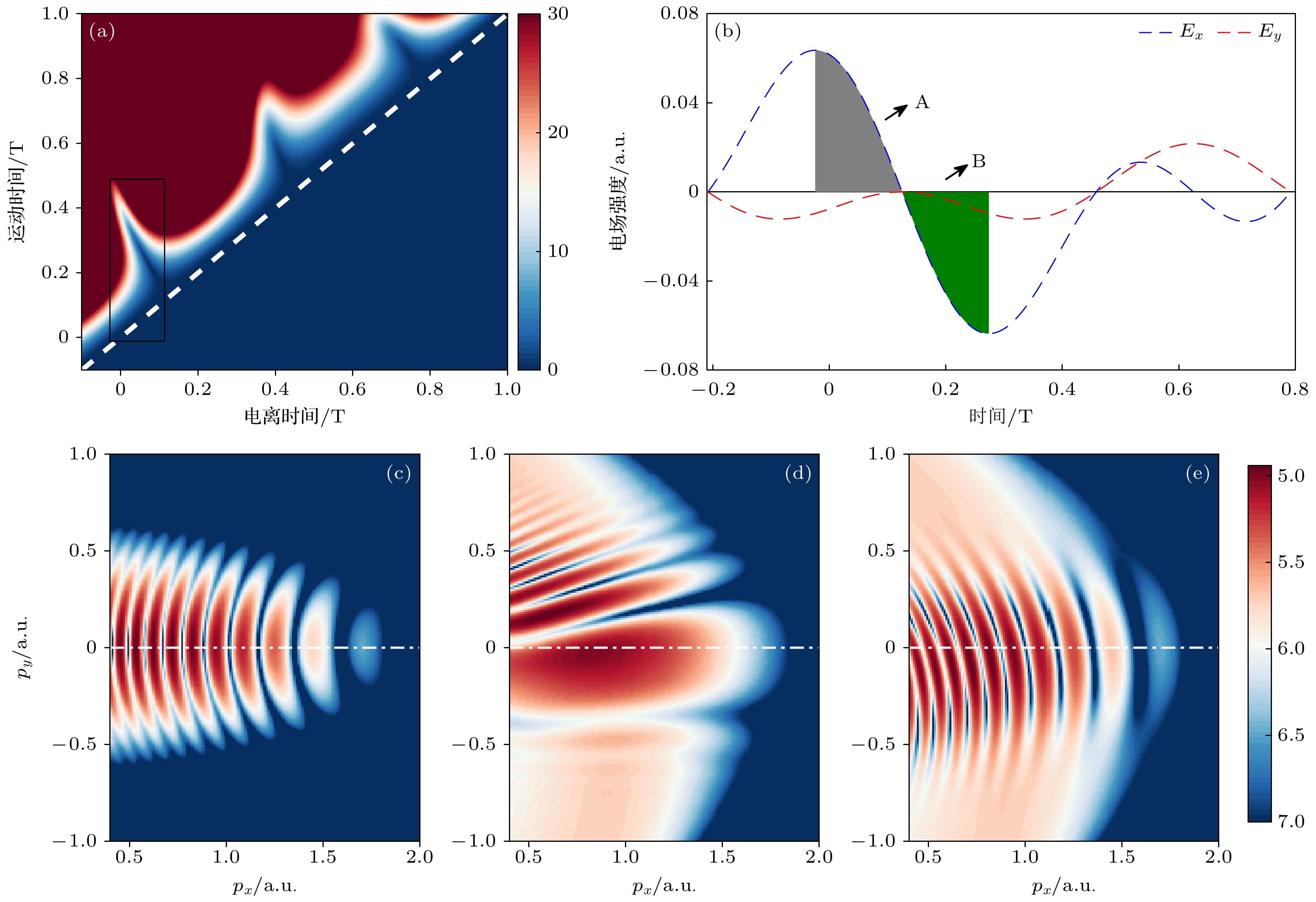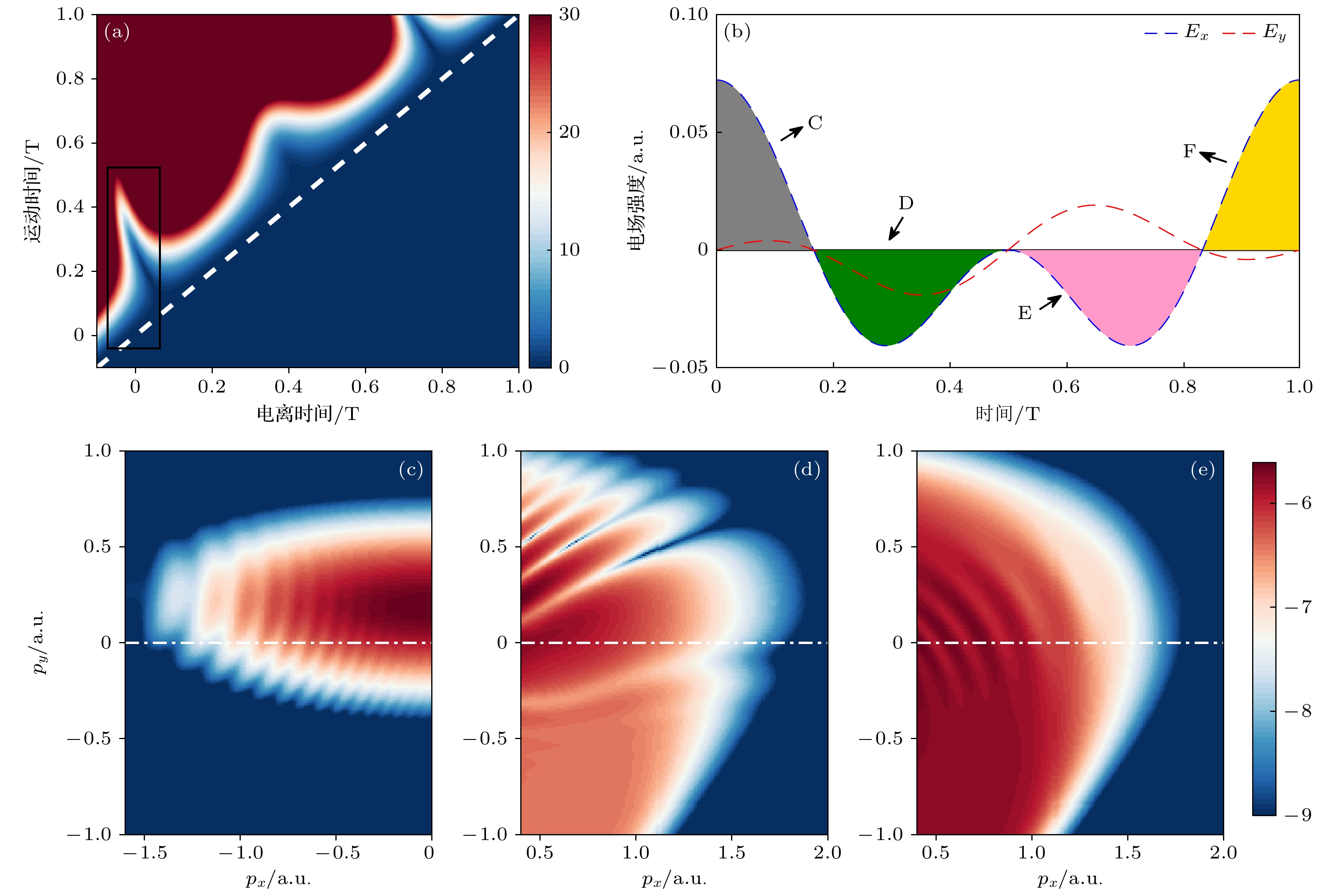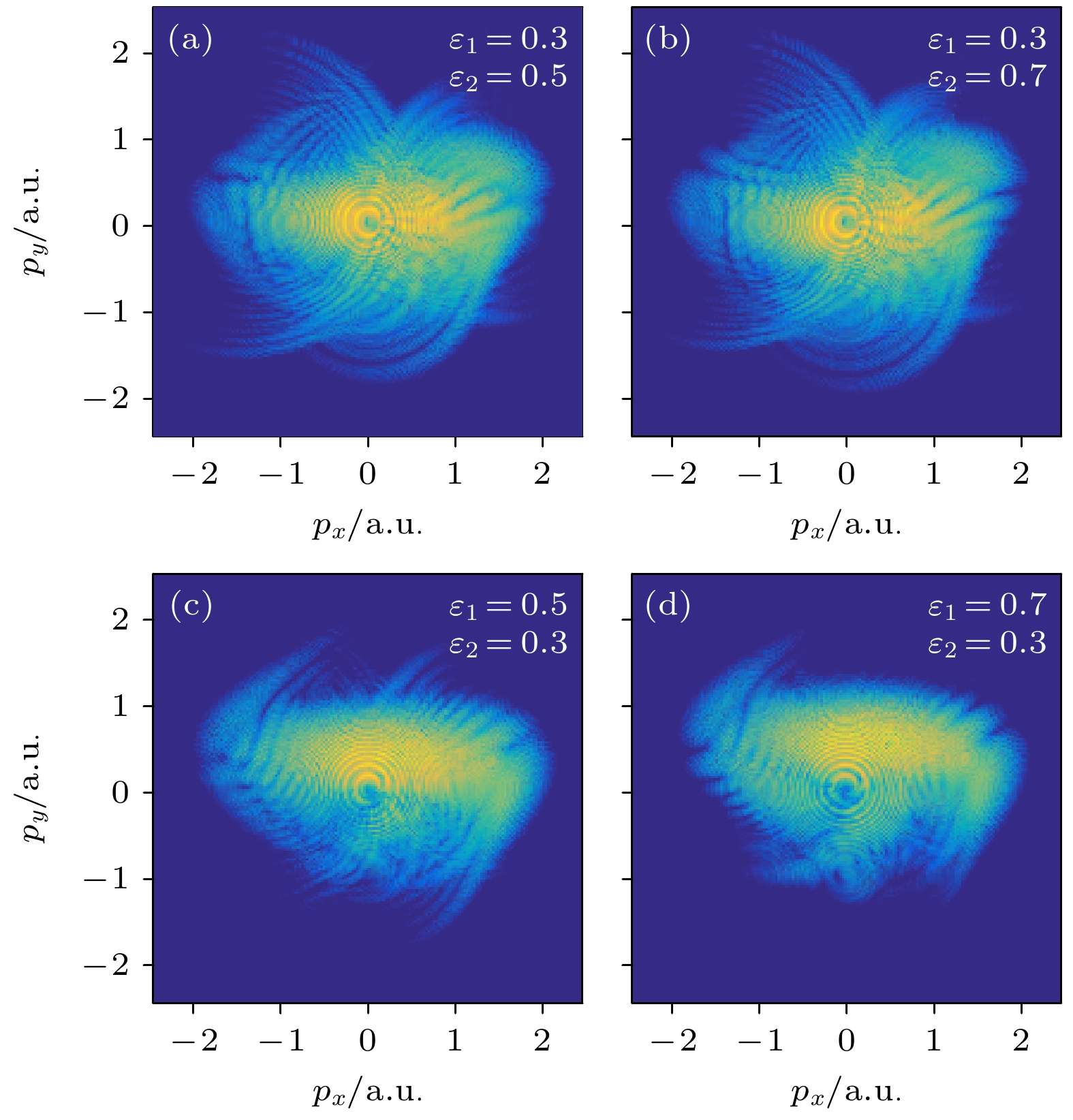-
利用数值求解含时薛定谔方程和强场近似理论研究了反向旋转双色椭偏光场中氩原子隧穿电离电子的干涉. 固定两脉冲的椭偏率均为0.3, 当两椭偏场的相对相位为0.25π时, 光电子动量谱中周期内干涉、叉状全息干涉和弧形全息干涉相互重叠. 当两椭偏场的相对相位为0时, 光电子动量谱中弧形全息干涉消除, 并且周期内干涉和叉状全息干涉被彻底分离到动量谱的左右部分, 从而得到一个在空间上独立的叉状全息干涉条纹. 进一步研究表明, 通过改变两椭偏光场的椭偏率还可以增强或抑制该独立叉状全息干涉条纹. 这为干涉条纹的控制和分离提供了一个有效的手段, 同时也有利于从全息干涉条纹中提取靶材结构信息和电子超快动力学信息.In this paper, photoelectron interference in tunneling ionization of atoms by counter-rotating two-color elliptically polarized (TCEP) laser fields are investigated by numerically solving the two-dimensional time-dependent Schrödinger equation (TDSE) and strong field approximation (SFA). When the ellipticities of the two pulses are both 0.3, for a relative phase of 0.25π, the intracycle interference, fork-like holographic interference and arc-like holographic interference in the photoelectron momentum distribution overlap with each other. For a relative phase of 0, the arc-like holographic interference disappears and the intracycle interference and fork-like holographic interference are fully separated into the –px direction and the +px direction. Furthermore, the independent fork-like holographic interference can be enhanced or suppressed by changing the ellipticities of the two pulses. This provides an efficient tool for controlling and separating the interference structures in the photoelectron momentum distribution, which facilitates extracting the information about the target structure and the photoelectron ultrafast dynamics in strong fields.
-
Keywords:
- tunneling ionization /
- two-color laser fields /
- relative phase /
- photoelectron holographic interference
[1] Corkum P 1993 Phys. Rev. Lett. 71 1994
 Google Scholar
Google Scholar
[2] Agostini P, Fabre F, Mainfray G, Petite G 1979 Phys. Rev. Lett. 42 1127
 Google Scholar
Google Scholar
[3] Arbó D G, Persson E, Burgdörfer J 2006 Phys. Rev. A 74 063407
 Google Scholar
Google Scholar
[4] Tan J, Xu S, Han X, Zhou Y, Li M, Cao W, Zhang Q, Lu P 2021 Adv. Photonics 3 035001
 Google Scholar
Google Scholar
[5] Li M, Zhang P, Luo S Q, Zhou Y M, Zhang Q B, Lan P F, Lu P X 2015 Phys. Rev. A 92 063404
 Google Scholar
Google Scholar
[6] Yang W, Zhang H, Lin C, Xu J, Sheng Z, Song X, Hu S, Chen J 2016 Phys. Rev. A 94 043419
 Google Scholar
Google Scholar
[7] Wang Y, Yu S, Lai X, Kang H, Xu S, Sun R, Quan W, Liu X 2018 Phys. Rev. A 98 043422
 Google Scholar
Google Scholar
[8] Huismans Y, Rouzée A, Gijsbertsen A, Jungmann J H, Smolkowska A S, Logman P S W M, Lépine F, Cauchy C, Zamith S, Marchenko T, Bakker J M, Berden G, Redlich B, van der Meer A F G, Muller H G, Vermin W, Schafer K J, Spanner M, Ivanov M Yu, Smirnova O, Bauer D, Popruzhenko S V, Vrakking M J J 2011 Science 331 6164
 Google Scholar
Google Scholar
[9] Xia Q, Tao J, Cai J, Fu L, Liu J 2018 Phys. Rev. Lett. 121 143201
 Google Scholar
Google Scholar
[10] Du H, Li J, Wang H, Yue S, Wu H, Hu B 2017 Phys. Lett. A 381 1563
 Google Scholar
Google Scholar
[11] Chen F, Yao R, Luo J, Wang C 2018 Chin. Phys. B 27 103202
 Google Scholar
Google Scholar
[12] Marchenko T, Huismans Y, Schafer K J, Vrakking M J J 2011 Phys. Rev. A 84 053427
 Google Scholar
Google Scholar
[13] Bian X B, Huismans Y, Smirnova O, Yuan K J, Vrakking M J J, Bandrauk A D 2011 Phys. Rev. A 84 043420
 Google Scholar
Google Scholar
[14] Bian X B, Bandrauk A D, 2012 Phys. Rev. Lett. 108 263003
 Google Scholar
Google Scholar
[15] Song X, Lin C, Sheng Z, Liu P, Chen Z, Yang W, Hu S, Lin C D, Chen J 2016 Sci. Rep. 6 28392
 Google Scholar
Google Scholar
[16] 林呈, 张华堂, 盛志浩, 余显环, 刘鹏, 徐竟文, 宋晓红, 胡师林, 陈京, 杨玮枫 2016 65 223207
 Google Scholar
Google Scholar
Lin C, Zhang H J, Sheng Z H, Yu X H, Liu P, Xu J W, Song X H, Hu S L, Chen J, Yang W F 2016 Acta Phys. Sin. 65 223207
 Google Scholar
Google Scholar
[17] Qin P, Sun X, Liu Y, Chen Z 2021 Phys. Rev. A 104 053111
 Google Scholar
Google Scholar
[18] Yu S, Lai X, Wang Y, Xu S, Hua L, Quan W, Liu X 2020 Phys. Rev. A 101 023414
 Google Scholar
Google Scholar
[19] Zhou Y, Tolstikhin O I, Morishita T 2016 Phys. Rev. Lett. 116 173001
 Google Scholar
Google Scholar
[20] Hickstein D D, Ranitovic P, Witte S, Tong X M, Huismans Y, Arpin P, Zhou X, Keister K E, Hogle C W, Zhang B, Ding C, Johnsson P, Toshima N, Vrakking M J J, Murnane M M, Kapteyn H C 2012 Phys. Rev. Lett. 109 073004
 Google Scholar
Google Scholar
[21] Zhou Y, Tan J, Li M, Lu P 2021 Sci. China Phys. Mech. Astron. 64 273011
 Google Scholar
Google Scholar
[22] Meckel M, Staudte A, Patchkovskii S, Villeneuve D M, Corkum P B, Drner R, Spanner M 2014 Nat. Phys. 10 594
 Google Scholar
Google Scholar
[23] Liu M M, Li M, Wu C, Gong Q, Staudte A, Liu Y 2016 Phys. Rev. Lett. 116 163004
 Google Scholar
Google Scholar
[24] Li M, Xie H, Cao W, Luo S, Tan J, Feng Y, Du B, Zhang W, Li Y, Zhang Q, Lan P, Zhou Y, Lu P X 2019 Phys. Rev. Lett. 122 183202
 Google Scholar
Google Scholar
[25] Tan J, Zhou Y, He M, Chen Y, Ke Q, Liang J, Zhu X, Li M, Lu P X 2018 Phys. Rev. Lett. 121 253203
 Google Scholar
Google Scholar
[26] Tan J, Zhou Y, He M, Ke Q, Liang J T, Li Y, Li M, Lu P X 2019 Phys. Rev. A 99 033402
 Google Scholar
Google Scholar
[27] Haertelt M, Bian X B, Spanner M, Staudte A, Corkum P B 2016 Phys. Rev. Lett. 116 133001
 Google Scholar
Google Scholar
[28] Porat G, Alon G, Rozen S, Pedatzur O, Krüger M, Azoury D, Natan A, Orenstein G, Bruner B D, Vrakking M J J, Dudovich N 2018 Nat. Commun 9 2805
 Google Scholar
Google Scholar
[29] He M, Li Y, Zhou Y, Li M, Cao W, Lu P 2018 Phys. Rev. Lett. 120 133204
 Google Scholar
Google Scholar
[30] Walt S G, Bhargava Ram N, Atala M, Shvetsov Shilovski N I, von Conta A, Baykusheva D, Lein M, Worner H J 2017 Nat. Commun. 8 15651
 Google Scholar
Google Scholar
[31] Hasovic E, Becker W, Milosević D B 2016 Opt. Express 24 6413
 Google Scholar
Google Scholar
[32] Huang C, Pang H, Huang X, Zhong M, Wu Z 2020 Opt. Express 28 10505
 Google Scholar
Google Scholar
[33] Li B, Yang X, Ren X, Zhang J 2019 Opt. Express 27 32700
 Google Scholar
Google Scholar
[34] Xu T, Zhu Q, Chen J, Ben S, Zhang J, Liu X 2018 Opt. Express 26 1645
 Google Scholar
Google Scholar
[35] 曾雪, 苏杰, 黄雪飞, 庞惠玲, 黄诚 2021 70 243201
 Google Scholar
Google Scholar
Zeng X, Su J, Huang X F, Pang H L, Huang C 2021 Acta Phys. Sin. 70 243201
 Google Scholar
Google Scholar
[36] Li M, Jiang W C, Xie H, Luo S, Zhou Y M, Lu P X 2018 Phys. Rev. A 97 023415
 Google Scholar
Google Scholar
[37] Ke Q H, Zhou Y M, Tan J, He M R, Liang J T, Zhao Y, Li M, Lu P X 2019 Opt. Express 27 32193
 Google Scholar
Google Scholar
[38] Feit M D, Fleck J A, Steiger A 1982 J. Comput. Phys. 47 412
 Google Scholar
Google Scholar
[39] Tong X M, Hino K, Toshima N 2006 Phys. Rev. A 74 031405
 Google Scholar
Google Scholar
[40] Liao Q, Winney A H, Lee S K, Lin Y, Adhikari P, Li W 2017 Phys. Rev. A 96 023401
 Google Scholar
Google Scholar
[41] Lehtovaara L, Toivanen J, Eloranta J 2007 J. Comput. Phys. 221 148
 Google Scholar
Google Scholar
[42] Lewenstein M, Balcou P, Ivanov M Yu, Anne L'Huillier, Corkum P B 1994 Phys. Rev. A 49 2117
 Google Scholar
Google Scholar
[43] Milošević D B, Becker W 2002 Phys. Rev. A 66 063417
 Google Scholar
Google Scholar
-
图 1 (a), (b)反向旋转TCEP复合电场(虚线)及其负矢势(实线); (c), (d)反向旋转TCEP场中Ar电离电子的末态动量分布; 其中(a), (c)相对相位为φ = 0.25π; (b), (d)相对相位φ = 0; 两椭偏场的椭偏率均为0.3
Fig. 1. (a), (b) Combined laser electric field E(t) (dashed curve) and the corresponding negative vector potential-A(t) (solid curve) for counter-rotating TCEP fields; (c), (d) photoelectron momentum distributions of Ar ionized by counter-rotating TCEP fields. (a), (c) The relative phase is φ = 0.25π; (b), (d) The relative phase is φ = 0. Both ellipticities of the two pulses are 0.3.
图 2 (a) 不同时刻电离电子经典轨迹中电子离母离子距离的时间演化; (b) 反向旋转TCEP场的x分量(蓝虚线)和y分量(红虚线); (c) SFA计算所得直接电子波包A和直接电子波包B形成的干涉图样; (d) SFA计算所得前向散射电子波包A和直接电子波包A形成的干涉图样; (e) SFA计算所得前向散射电子波包A和直接电子波包B形成的干涉图样. 两椭偏场的椭偏率均为0.3. 相对相位φ = 0.25π
Fig. 2. (a) Time evolutions of the distances between the electron and the parent ion for different ionization times; (b) the x and y components of counter-rotating TCEP fields; (c) the simulated interference pattern between the direct electrons ionized during A and the direct electrons ionized during B with SFA; (d) the simulated interference pattern between the rescattering electrons and the direct electrons ionized during A with SFA; (e) the simulated interference pattern between the rescattering electrons ionized during A and the direct electrons ionized during B with SFA. Both ellipticities of the two pulses are 0.3. The relative phase is 0.25π.
图 3 (a) 不同时刻电离电子经典轨迹中电子离母离子距离的时间演化; (b) 反向旋转TCEP场的x分量(蓝虚线)和y分量(红虚线); (c) SFA计算所得直接电子波包E和直接电子波包F形成的干涉图样; (d) SFA计算所得前向散射电子波包C和直接电子波包C形成的干涉图样; (e) SFA计算所得前向散射电子波包C和直接电子波包D形成的干涉图样. 两椭偏场的椭偏率均为0.3. 相对相位φ = 0
Fig. 3. (a) Time evolutions of the distances between the electron and the parent ion for different ionization times; (b) the x and y components of counter-rotating TCEP fields; (c) the simulated interference pattern between the direct electrons ionized during C and the direct electrons ionized during D with SFA; (d) the simulated interference pattern between the rescattering electrons and the direct electrons ionized during C with SFA; (e) the simulated interference pattern between the rescattering electrons during C and the direct electrons ionized during D with SFA. Both ellipticities of the two pulses are 0.3. The relative phase is 0.
图 4 反向旋转TCEP场驱动Ar原子隧穿电离电子末态动量分布, 其中两椭偏场的相对相位φ = 0; 两脉冲椭偏率分别为(a)
$\varepsilon_1 $ = 0.3,$\varepsilon_2 $ = 0.5; (b)$\varepsilon_1 $ = 0.3,$\varepsilon_2 $ = 0.7; (c)$\varepsilon_1 $ = 0.5,$\varepsilon_2 $ = 0.3; (d)$\varepsilon_1 $ = 0.7,$\varepsilon_2 $ = 0.3Fig. 4. Photoelectron momentum distributions of Ar ionized by counter-rotating TCEP fields. The relative phase is 0. The ellipticities of the two pulses: (a)
$\varepsilon_1 $ = 0.3,$\varepsilon_2 $ = 0.5; (b)$\varepsilon_1 $ = 0.3,$\varepsilon_2 $ = 0.7; (c)$\varepsilon_1 $ = 0.5,$\varepsilon_2 $ = 0.3; (d)$\varepsilon_1 $ = 0.7,$\varepsilon_2 $ = 0.3. -
[1] Corkum P 1993 Phys. Rev. Lett. 71 1994
 Google Scholar
Google Scholar
[2] Agostini P, Fabre F, Mainfray G, Petite G 1979 Phys. Rev. Lett. 42 1127
 Google Scholar
Google Scholar
[3] Arbó D G, Persson E, Burgdörfer J 2006 Phys. Rev. A 74 063407
 Google Scholar
Google Scholar
[4] Tan J, Xu S, Han X, Zhou Y, Li M, Cao W, Zhang Q, Lu P 2021 Adv. Photonics 3 035001
 Google Scholar
Google Scholar
[5] Li M, Zhang P, Luo S Q, Zhou Y M, Zhang Q B, Lan P F, Lu P X 2015 Phys. Rev. A 92 063404
 Google Scholar
Google Scholar
[6] Yang W, Zhang H, Lin C, Xu J, Sheng Z, Song X, Hu S, Chen J 2016 Phys. Rev. A 94 043419
 Google Scholar
Google Scholar
[7] Wang Y, Yu S, Lai X, Kang H, Xu S, Sun R, Quan W, Liu X 2018 Phys. Rev. A 98 043422
 Google Scholar
Google Scholar
[8] Huismans Y, Rouzée A, Gijsbertsen A, Jungmann J H, Smolkowska A S, Logman P S W M, Lépine F, Cauchy C, Zamith S, Marchenko T, Bakker J M, Berden G, Redlich B, van der Meer A F G, Muller H G, Vermin W, Schafer K J, Spanner M, Ivanov M Yu, Smirnova O, Bauer D, Popruzhenko S V, Vrakking M J J 2011 Science 331 6164
 Google Scholar
Google Scholar
[9] Xia Q, Tao J, Cai J, Fu L, Liu J 2018 Phys. Rev. Lett. 121 143201
 Google Scholar
Google Scholar
[10] Du H, Li J, Wang H, Yue S, Wu H, Hu B 2017 Phys. Lett. A 381 1563
 Google Scholar
Google Scholar
[11] Chen F, Yao R, Luo J, Wang C 2018 Chin. Phys. B 27 103202
 Google Scholar
Google Scholar
[12] Marchenko T, Huismans Y, Schafer K J, Vrakking M J J 2011 Phys. Rev. A 84 053427
 Google Scholar
Google Scholar
[13] Bian X B, Huismans Y, Smirnova O, Yuan K J, Vrakking M J J, Bandrauk A D 2011 Phys. Rev. A 84 043420
 Google Scholar
Google Scholar
[14] Bian X B, Bandrauk A D, 2012 Phys. Rev. Lett. 108 263003
 Google Scholar
Google Scholar
[15] Song X, Lin C, Sheng Z, Liu P, Chen Z, Yang W, Hu S, Lin C D, Chen J 2016 Sci. Rep. 6 28392
 Google Scholar
Google Scholar
[16] 林呈, 张华堂, 盛志浩, 余显环, 刘鹏, 徐竟文, 宋晓红, 胡师林, 陈京, 杨玮枫 2016 65 223207
 Google Scholar
Google Scholar
Lin C, Zhang H J, Sheng Z H, Yu X H, Liu P, Xu J W, Song X H, Hu S L, Chen J, Yang W F 2016 Acta Phys. Sin. 65 223207
 Google Scholar
Google Scholar
[17] Qin P, Sun X, Liu Y, Chen Z 2021 Phys. Rev. A 104 053111
 Google Scholar
Google Scholar
[18] Yu S, Lai X, Wang Y, Xu S, Hua L, Quan W, Liu X 2020 Phys. Rev. A 101 023414
 Google Scholar
Google Scholar
[19] Zhou Y, Tolstikhin O I, Morishita T 2016 Phys. Rev. Lett. 116 173001
 Google Scholar
Google Scholar
[20] Hickstein D D, Ranitovic P, Witte S, Tong X M, Huismans Y, Arpin P, Zhou X, Keister K E, Hogle C W, Zhang B, Ding C, Johnsson P, Toshima N, Vrakking M J J, Murnane M M, Kapteyn H C 2012 Phys. Rev. Lett. 109 073004
 Google Scholar
Google Scholar
[21] Zhou Y, Tan J, Li M, Lu P 2021 Sci. China Phys. Mech. Astron. 64 273011
 Google Scholar
Google Scholar
[22] Meckel M, Staudte A, Patchkovskii S, Villeneuve D M, Corkum P B, Drner R, Spanner M 2014 Nat. Phys. 10 594
 Google Scholar
Google Scholar
[23] Liu M M, Li M, Wu C, Gong Q, Staudte A, Liu Y 2016 Phys. Rev. Lett. 116 163004
 Google Scholar
Google Scholar
[24] Li M, Xie H, Cao W, Luo S, Tan J, Feng Y, Du B, Zhang W, Li Y, Zhang Q, Lan P, Zhou Y, Lu P X 2019 Phys. Rev. Lett. 122 183202
 Google Scholar
Google Scholar
[25] Tan J, Zhou Y, He M, Chen Y, Ke Q, Liang J, Zhu X, Li M, Lu P X 2018 Phys. Rev. Lett. 121 253203
 Google Scholar
Google Scholar
[26] Tan J, Zhou Y, He M, Ke Q, Liang J T, Li Y, Li M, Lu P X 2019 Phys. Rev. A 99 033402
 Google Scholar
Google Scholar
[27] Haertelt M, Bian X B, Spanner M, Staudte A, Corkum P B 2016 Phys. Rev. Lett. 116 133001
 Google Scholar
Google Scholar
[28] Porat G, Alon G, Rozen S, Pedatzur O, Krüger M, Azoury D, Natan A, Orenstein G, Bruner B D, Vrakking M J J, Dudovich N 2018 Nat. Commun 9 2805
 Google Scholar
Google Scholar
[29] He M, Li Y, Zhou Y, Li M, Cao W, Lu P 2018 Phys. Rev. Lett. 120 133204
 Google Scholar
Google Scholar
[30] Walt S G, Bhargava Ram N, Atala M, Shvetsov Shilovski N I, von Conta A, Baykusheva D, Lein M, Worner H J 2017 Nat. Commun. 8 15651
 Google Scholar
Google Scholar
[31] Hasovic E, Becker W, Milosević D B 2016 Opt. Express 24 6413
 Google Scholar
Google Scholar
[32] Huang C, Pang H, Huang X, Zhong M, Wu Z 2020 Opt. Express 28 10505
 Google Scholar
Google Scholar
[33] Li B, Yang X, Ren X, Zhang J 2019 Opt. Express 27 32700
 Google Scholar
Google Scholar
[34] Xu T, Zhu Q, Chen J, Ben S, Zhang J, Liu X 2018 Opt. Express 26 1645
 Google Scholar
Google Scholar
[35] 曾雪, 苏杰, 黄雪飞, 庞惠玲, 黄诚 2021 70 243201
 Google Scholar
Google Scholar
Zeng X, Su J, Huang X F, Pang H L, Huang C 2021 Acta Phys. Sin. 70 243201
 Google Scholar
Google Scholar
[36] Li M, Jiang W C, Xie H, Luo S, Zhou Y M, Lu P X 2018 Phys. Rev. A 97 023415
 Google Scholar
Google Scholar
[37] Ke Q H, Zhou Y M, Tan J, He M R, Liang J T, Zhao Y, Li M, Lu P X 2019 Opt. Express 27 32193
 Google Scholar
Google Scholar
[38] Feit M D, Fleck J A, Steiger A 1982 J. Comput. Phys. 47 412
 Google Scholar
Google Scholar
[39] Tong X M, Hino K, Toshima N 2006 Phys. Rev. A 74 031405
 Google Scholar
Google Scholar
[40] Liao Q, Winney A H, Lee S K, Lin Y, Adhikari P, Li W 2017 Phys. Rev. A 96 023401
 Google Scholar
Google Scholar
[41] Lehtovaara L, Toivanen J, Eloranta J 2007 J. Comput. Phys. 221 148
 Google Scholar
Google Scholar
[42] Lewenstein M, Balcou P, Ivanov M Yu, Anne L'Huillier, Corkum P B 1994 Phys. Rev. A 49 2117
 Google Scholar
Google Scholar
[43] Milošević D B, Becker W 2002 Phys. Rev. A 66 063417
 Google Scholar
Google Scholar
计量
- 文章访问数: 5549
- PDF下载量: 102
- 被引次数: 0














 下载:
下载:



















